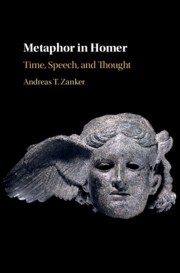Book contents
- Metaphor in Homer
- Metaphor in Homer
- Copyright page
- Contents
- Figures
- Preface
- Note on Texts and Translations
- Abbreviations
- Introduction
- Chapter 1 Ancient and Modern Views on Metaphor in Homer
- Chapter 2 Conceptual Metaphors for Time in Homer
- Chapter 3 Conceptual Metaphors for Speech in Homer
- Chapter 4 Conceptual Metaphors for Mind, Intention, and Self in Homer
- Conclusion
- Book part
- Bibliography
- General Index
- Index Verborum
- Index Locorum
Introduction
Published online by Cambridge University Press: 29 July 2019
- Metaphor in Homer
- Metaphor in Homer
- Copyright page
- Contents
- Figures
- Preface
- Note on Texts and Translations
- Abbreviations
- Introduction
- Chapter 1 Ancient and Modern Views on Metaphor in Homer
- Chapter 2 Conceptual Metaphors for Time in Homer
- Chapter 3 Conceptual Metaphors for Speech in Homer
- Chapter 4 Conceptual Metaphors for Mind, Intention, and Self in Homer
- Conclusion
- Book part
- Bibliography
- General Index
- Index Verborum
- Index Locorum
Summary
In the Introduction, the author goes through conceptual metaphor theory and conceptual blending theory, illustrating how conceptual metaphors arise from the embodied and cultural situation of human actors. He then argues that such approaches are productive when it comes to Homer, allowing us to understand entire domains of experience in coherent ways. He also argues that the Homeric corpus is important for the modern theory in general, since Homer represents the earliest sustained text in the unbroken western tradition in which time, speech, and thought are described.
- Type
- Chapter
- Information
- Metaphor in HomerTime, Speech, and Thought, pp. 1 - 29Publisher: Cambridge University PressPrint publication year: 2019

